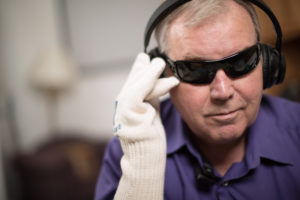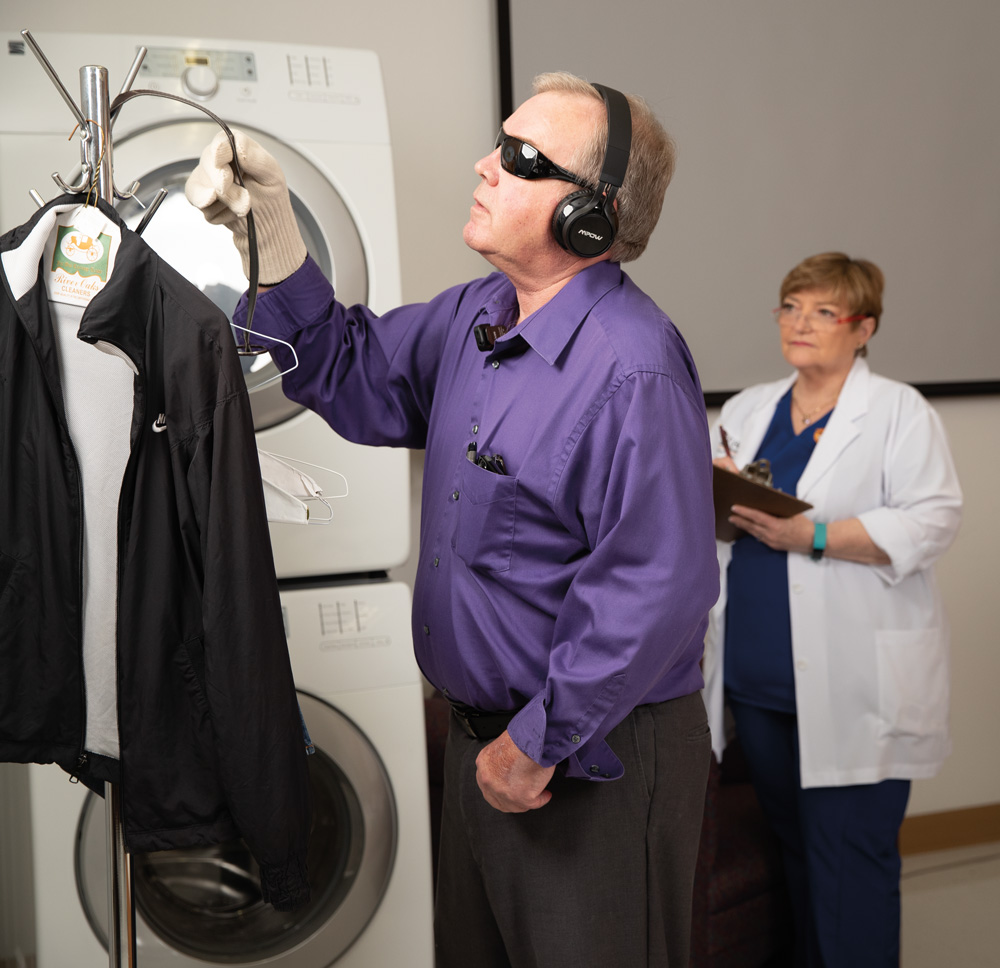By Joe Michael Feist
Stabbing pains shot through my feet with every step, every turn. My vision was chalky and distorted. I ran into objects, couldn’t pick up a fork or knife without a struggle, and heard nothing but a god-awful, buzzing white noise. The small apartment was vaguely familiar yet foreign. Disoriented and confused, I kept trying to complete simple tasks I had been assigned, but couldn’t even remember the instructions. I felt slightly stupid and strangely lost inside what used to be my body. And under my breath, or so I thought, I cursed my predicament quite freely.
Most of all, for six excruciating minutes, I just wanted it to be over.

On this sunny spring day, I felt fine, but in a matter of minutes was about to find out what it would be like to lose my mind. The Virtual Dementia Tour is a controlled simulation of dementia symptoms and part of the overall Caring for the Caregivers program run by the School of Nursing. The tour aims to give caregivers a greater understanding of dementia and an enhanced sense of empathy for those struggling with it.
Dementia is the torturous unraveling of memory and brain function. It occurs most often in those of an advanced age, and so it’s often accompanied by other symptoms such as vision and hearing loss, neuropathy—which causes numbness or weakness in the arms or legs—and loss of dexterity. Because of the cognitive decline associated with the disease, those with dementia are often unable to communicate or explain their feelings and behaviors.
It can be a nightmare for caregivers as well, most of whom are family members with little or no training or understanding of the illness—or how to cope with an uncommunicative and seemingly uncooperative patient.
The Virtual Dementia Tour, developed by Atlanta-based Second Wind Dreams and licensed to UT Health San Antonio, is meant to give caregivers “a glimpse into the world of dementia,” said Deborah James, M.S.N., RN, a clinical assistant professor in the School of Nursing and director of the dementia tour. And, she added, a better understanding of the challenges dementia patients face can only lead to better caregiving.
This is especially critical in light of some startling facts. Age is the greatest risk factor for developing dementia, and the number of Americans over 65 is expected to double by 2060. In Texas, according to the Department of State Health Services, a new person develops Alzheimer’s disease every 65 seconds, and current projections indicate that this rate will increase to one new case every 33 seconds by 2050.
Alzheimer’s disease, the most common form of dementia, affects an estimated 5.7 million people in the U.S.; 380,000 are Texans. The disease disproportionately affects women, African Americans and Hispanics.

For the tour, which lasts only six minutes, I was outfitted with inserts in my shoes that have probes that dig into the feet. “That’s to simulate neuropathy or diabetic neuropathy, like pins and needles in your feet,” James explained. Then a padded glove was placed on my dominant hand to impede dexterity. Thick glasses distorted my vision and simulated glaucoma and other vision problems. Headphones with white noise caused hearing loss and added to the general confusion.
Uncomfortable and a bit bewildered, I was given five simple tasks, which I was to perform in a room furnished like a small apartment. But like many who take the tour, the white noise and the disorientation meant that I didn’t clearly understand the verbal instructions or recall them later. I was told to “put the coffee in the refrigerator,” but only heard the words “coffee” and “refrigerator.” I was asked to “buckle the belt,” but only heard “belt.” Of the tasks assigned, I completed none.
“All of the things being simulated are very common in those with dementia or those with Alzheimer’s,” James said.
My tour was a marathon of frustration, pain, embarrassment and defeat. I fearfully thought, “If this is what dementia is like, God spare me.” That emotion is common, according to the Centers for Disease Control and Prevention, which found that Americans fear losing their mental functions twice as much as they fear losing their physical abilities.
After the tours, which are closely monitored, James debriefs the participants so that they more fully understand what transpired and how it might relate to their caregiving.
The experience, the sudden realization of what dementia feels like, can be life changing for the caregiver. And raw emotions sometimes overwhelm the tour participant, James explained.
“One man said, ‘I feel so ashamed,’” she recalled. “He said, ‘I try to protect my wife, but I never realized that it hurts so bad just to get your damn shoes on. I didn’t know she was in that kind of discomfort. And I never thought that she couldn’t hear me.’”
Like other caregivers, the man thought his wife simply didn’t want to cooperate.
Sheran Rivette, who works part time in the Caring for the Caregiver program, was the full-time caregiver for her husband, who had Alzheimer’s disease, for six years before his death in February 2017. She now cares one day a week for a man with Alzheimer’s, giving his wife a much-needed respite.
She recently experienced the dementia tour, but, for her late husband’s sake, wishes she had had the chance to do it years ago.
“At first, after doing the tour,” she said, “I had sadness because I had not been as sensitive in understanding his conditions and his actions as I could have been. Should have been.” Her voice trailed off. “Wish I had been,” she added softly.
Almost worse than the disease itself are the moments of clarity, in which the person with dementia realizes how much they’ve lost.
“I think the person is disappointed when they can’t complete simple tasks,” Rivette said. “I think they’re embarrassed because they feel foolish, they feel stupid. My husband often said, ‘I’m just stupid. I don’t know anything.’”
Now, she added, with the man she cares for weekly, she’s more patient, more tolerant, more willing to try different approaches to break through the fog of the disease.
“I would encourage every caregiver to take this tour,” Rivette said. “To empathize is different than to sympathize. I believe empathy is huge. We need to put ourselves in other people’s shoes.”
By far, family members provide most of the care for loved ones with dementia or Alzheimer’s disease, said nursing professor Carole White, Ph.D., RN, who directs the Caring for the Caregiver program. In 2017, an estimated 15 million Americans provided 18 billion hours of unpaid care for family members and friends with Alzheimer’s and other dementias.

Often, Dr. White said, it comes at “great personal cost to their physical health, their emotional health, their social and financial health.”
That’s why the comprehensive Caring for the Caregiver program that offers education, skills training, research and community engagement is so needed, she said, especially in light of the coming “tsunami” of people with Alzheimer’s disease and other dementias.
After my dementia tour, as I massaged my aching feet, regained my balance, was told how much I swore and was reminded of how I didn’t really do the things I was asked to do, James added a sobering shot of reality.
“Remember,” she said. “This was only six minutes of your time. It’s every minute of some people’s time.”
The School of Nursing and the Glenn Biggs Institute for Alzheimer’s and Neurodegenerative Diseases work together to support the health and well-being of people with dementia and their family members. To learn more about the Caring for the Caregiver program and the Virtual Dementia Tour, visit UTcaregivers.org, call (210) 450-8487 or email masoud@uthscsa.edu.

Excellent article
Having just lost a sister to PSP and while Dementia is not PSP, this article was emotionally moving for me as I pictured the inner chaos of my sister’s last months. Will this be a tool for Medical Service Providers or Medical students?
Thank you for sharing about this excellent resource! One thing I would like to point out is that, yes, Alzheimer’s Disease and related dementias are terrible diseases. But even with the many challenges entailed– to one’s memory and sensory functioning– those affected are still quite capable of feeling joy, belonging, and full spectrum of rewarding human emotions.
I would be interested in doing the virtual dementia tour. My husband’s dad is has Alzheimer’s & my mother is going through the beginning of dementia. I would like to get a better understanding of what they are going through….